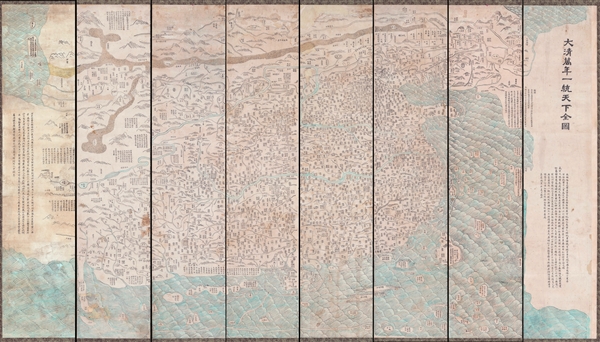This item has been sold, but you can get on the Waitlist to be notified if another example becomes available, or purchase a digital scan.
1806 Qing Chinese Qianren Huang Map of China (DaQing Wannian Yitong Tianxia Quantu)
DaQingQanNianYiTong-qing-1806
Title
1806 (dated) 53 x 93 in (134.62 x 236.22 cm) 1 : 2500000
Description
An initial examination of the easily recognizable portions of the map suggests an expansive coverage extending from Siberia to Borneo and from India to Korea. Closer examination, nonetheless, reveals that this is in fact a map of the world, scaled not in terms of distance, but rather in terms of degree of subjugation to and importance to Qing China. The map is read, like traditional Chinese texts, from right to left, with the most densely detailed regions corresponding to the eastern shores of China. At the far west, in the distant upper left hand corner, European countries like Holland, Portugal (Land of the Great Western Sea), possibly Italy, Arabia (Homeland of Islam), Africa (Land of the Black Ghosts), the Mediterranean (Little Western Sea), and even the Atlantic (Great Western Sea) are identified. Surrounding the map are textual annotations describing the subject peoples of various regions. The annotations identify not only the people, but the great distances their leaders travel, the great hardships they endure, and the gratefulness with which they suffer, to pay tribute to the mighty and culturally superior Qing. Thus the map takes on meaning as a ceremonial and administrative embodiment of Qing rule and the tribute system. The Manchu Qing were a nomadic people who did not visualize themselves limited by geo-political boundaries – and aptly there are none on this map – rather, their territorial dominion extended to wherever they exerted influence, and the significance of all other lands correspondingly diminished or increased according to that influence. A noted by Richard Pegg,
This 'complete' map minimizes the European notion of a map of the world, its centralized and marginalizing construct confirm the Qing / Chinese notion of the Central Kingdom (Pegg, R., Cartographic Traditions in East Asian Maps p. 19). A key to the right of the map helps to understand the map and identify its iconography. Although the translations are our own we are indebted to Richard Pegg, see above, for helping to define the administrative terminology.
- Sheng – provincial capital – square topped by a rectangle.
- Fu – prefecture – a square.
- Ting – sub-prefecture –oval.
- Zhilizhou – independent magistrate – small house with triangle roof.
- Zhou – department – rectangle.
- Xian – district – circle.
- Guan – frontier station – shaped like a small house. In the key, this icon is missing a roof, but the roofs are present on the map. This omission was corrected in the 1811 issue.
- Guanzhen – meaning unclear – double circle.
- Tusi – indigenous official.
Although others may be discovered, there currently several known variants of this map:
- 1767 Huang Qianren – no surviving examples.
- 1800 Manuscript – 1 surviving example in Beijing Library.
- 1806 Woodcut Printing - Present example. Only known example of this edition.
- 1811 Woodcut Printing - Blue Map (also printed in black) – multiple surviving examples in private and institutional collections.
- 1814 Woodcut Printing - Private collection.
- 1821 Woodcut Printing - Library of Congress
- 1883 Manuscript, Private Collection.
Cartographer
Qianren Huang (黃千人, 1694 – 1771) was a Chinese cartographer active 18th century during the reign of the Qianlong Emperor. He was born in Yuyao, Zhejiang, China. He passed the state civil service exam for Tai-an and was awarded a position as a clerk. His grandfather was the great Qing Chinese polymath and 'Father of the Chinese Enlightenment' Huang Zongxi (黄宗羲) (1610-1695), father of Huang Baijia (黃百家) (1643-1709). He is best known for his 1767 revision of Huang Zongzi's map 天下舆图, published as DaQing Wannian Yitong Tianxia Quantu (大清万年一统天下全图)or All-Under-Heaven Complete Map of the Everlasting Unified Qing Empire. More by this mapmaker...

